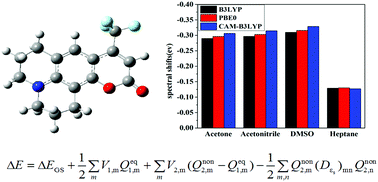Solvent effects on excitation energies obtained using the state-specific TD-DFT method with a polarizable continuum model based on constrained equilibrium thermodynamics
Abstract
Nonequilibrium solvation effects need to be treated properly in the study of electronic absorption processes of solutes since solvent polarization is not in equilibrium with the excited-state charge density of the solute. In this work, we developed a state specific (SS) method based on the novel nonequilibrium solvation model with constrained equilibrium manipulation to account for solvation effects in electronic absorption processes. Time-dependent density functional theory (TD-DFT) is adopted to calculate electronic excitation energies and a polarizable continuum model is employed in the treatment of bulk solvent effects on both the ground and excited electronic states. The equations based on this novel nonequilibrium solvation model in the framework of TDDFT to calculate vertical excitation energy are presented and implemented in the Q-Chem package. The implementation is validated by comparing reorganization energies for charge transfer excitations between two atoms obtained from Q-Chem and those obtained using a two-sphere model. Solvent effects on electronic transitions of coumarin 153 (C153), acetone, pyridine, (2E)-3-(3,4-dimethoxyphenyl)-1-(2-hydroxyphenyl)prop-2-en-1-one (DMHP), and uracil in different solvents are investigated using the newly developed code. Our results show that the obtained vertical excitation energies as well as spectral shifts generally agree better with the available experimental values than those obtained using the traditional nonequlibrium solvation model. This new model is thus appropriate to study nonequilibrium excitation processes in solution.

- This article is part of the themed collection: 2017 PCCP HOT Articles


 Please wait while we load your content...
Please wait while we load your content...